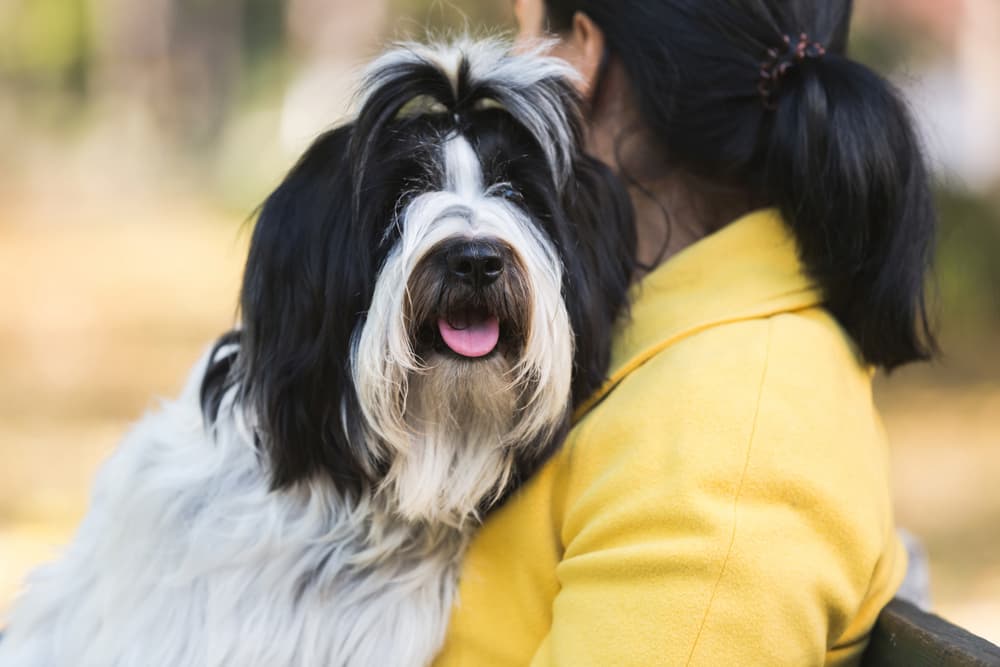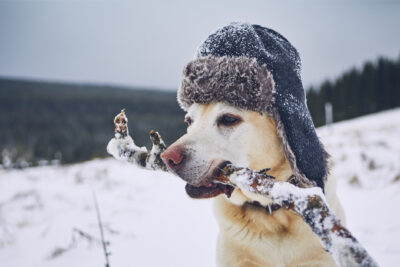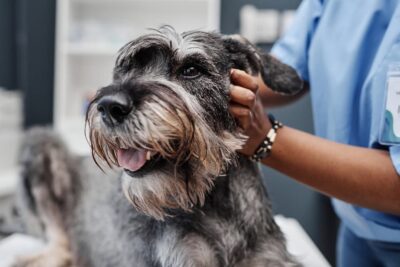Hypothyroidism in Dogs

Overview
Just like humans, dogs have a thyroid gland. This relatively small gland, located in the neck, produces thyroxine (T4) and other thyroid hormones, which are responsible for regulating metabolism and other bodily processes.
While thyroxine production is normally carefully regulated, thyroid disease can lead to hormone imbalances. The most common thyroid condition in dogs is hypothyroidism or low thyroxine production. Hypothyroidism is one of the most common hormonal diseases in dogs, and approximately 1 in 400 dogs receive a diagnosis of hypothyroidism in any given year (1).
What is Hypothyroidism in Dogs?
In a healthy dog, the thyroid gland releases a carefully-regulated flow of thyroxine and other thyroid hormones. Thyroxine’s primary role is controlling the body’s metabolism. It also regulates digestion, as well as the function of the skin, heart, brain, muscles, and reproductive organs.
Dogs with hypothyroidism have abnormally low levels of circulating thyroxine. This condition is relatively common in dogs, especially middle-aged and older dogs.
Hyperthyroidism, in contrast, refers to the production of excess thyroid hormone levels. While this condition is common in cats, it is very rare in dogs.
Causes of Hypothyroidism in Dogs

Hypothyroidism can be divided into two categories: congenital (inherited) and acquired.
Congenital hypothyroidism is caused by a mutation in the genes. In these dogs, the thyroid gland never develops normally. This form of hypothyroidism, which is diagnosed during puppyhood, is rare in dogs.
Acquired hypothyroidism, in contrast, refers to hypothyroidism that develops later in life. This is the most common form of canine hypothyroidism. Most cases are caused by an autoimmune reaction within the thyroid gland, which destroys healthy thyroid tissue. Less commonly, acquired hypothyroidism can be caused by thyroid tumors, thyroid cysts, trauma, or iodine deficiency.
Acquired hypothyroidism can occur in any dog, including both purebred and mixed breed dogs. The condition is most common in Doberman Pinschers, Boxers, and Tibetan Terriers.
Hypothyroidism in Dogs Symptoms
Symptoms of hypothyroidism in dogs can be vague. They can be mistaken for other conditions or confused with normal signs of aging.
The most common signs of hypothyroidism are weight gain and lethargy. Affected dogs often gain weight without any noticeable increase in food intake, due to a slowing of the metabolism.
Affected dogs may also develop signs of hair loss, a dull or brittle coat, and darkening of the skin. Less common signs may include vomiting or diarrhea, ocular (eye) changes, facial nerve paralysis, and changes in heart/lung function. Pacing and restlessness can also occur.
Some dogs develop a characteristic condition known as a “tragic face.” This appearance is caused by swelling and thickening of the skin on the head and face. Affected dogs may have a sad expression, caused by drooping eyelids and general sagging of the facial skin.
Here is a dog hypothyroidism symptoms checklist:
- Weight gain
- Lethargy
- Exercise intolerance
- Decreased appetite
- Hair loss
- Dull or brittle coat
- Darkening of the skin (hyperpigmentation)
- Vomiting
- Diarrhea
- White discoloration of the cornea (surface of the eye)
- Increased respiratory rate
- Facial paralysis
Diagnosing Hypothyroidism in Dogs

Your veterinarian may suspect hypothyroidism on the basis of your dog’s clinical exam findings. However, further testing is always needed to confirm the diagnosis.
Hypothyroidism is diagnosed with a blood panel. There are three tests included in a typical canine thyroid panel:
- Total T4: This test measures the total amount of thyroxine circulating in your dog’s bloodstream. A low Total T4 level suggests a possibility of hypothyroidism, but additional testing is required. Many normal dogs have low Total T4 levels at some point during the day, so a low Total T4 is not considered adequate to make a diagnosis.
- Free T4: This test measures free T4, which is the biologically active form of thyroxine. Free T4 is a more accurate indicator of hypothyroidism than Total T4. A low free T4 level confirms a diagnosis of hypothyroidism.
- TSH: This hormone, produced by the pituitary gland, signals the thyroid gland to produce thyroxine. In dogs with hypothyroidism, TSH levels are high because the body is trying to increase thyroxine production to adequate levels.
Additional testing, such as imaging, is rarely indicated for a diagnosis of hypothyroidism. However, in some cases of congenital hypothyroidism, your veterinarian may recommend X-rays to evaluate growth abnormalities.
Dog Hypothyroidism Treatment

Hypothyroidism is treated with levothyroxine, a synthetic thyroxine supplement. This medication is given by mouth. Most dogs take levothyroxine twice daily, but once-daily dosing may be adequate in some cases.
Your veterinarian will calculate your dog’s starting dose of levothyroxine based on your dog’s weight and current thyroid levels. (If you or a family member have hypothyroidism, you may notice that levothyroxine doses are much higher in dogs than they are in people.)
One month after starting treatment, your veterinarian will assess your dog’s Total T4 level. This will allow them to determine whether your dog remains on the starting dose or whether a dose adjustment is needed. Your veterinarian may increase or decrease your dog’s levothyroxine dose based upon the results of this test. Once your veterinarian determines the optimal levothyroxine dose for your dog, your dog should show signs of improvement within 4-6 weeks.
Your pet will remain on levothyroxine for the rest of their life. Your veterinarian will assess your dog’s Total T4 level every 6-12 months and make dose adjustments if needed.
What to Feed a Dog with Hypothyroidism
Dogs with hypothyroidism do not typically have any specific dietary requirements.
In most cases, affected overweight dogs begin to lose their excess weight once their thyroid hormone levels are brought back into a normal range. If your dog needs further assistance with weight loss, your veterinarian may recommend a restricted-calorie diet.
Cost to Treat Hypothyroidism in Dogs
Hypothyroidism is a relatively inexpensive condition to treat. Levothyroxine typically costs $20-$50 per month, depending on your dog’s weight and their required dosage.
Thyroid testing, which is typically performed once or twice yearly, costs $50-$100.
Hypothyroidism in Dogs Life Expectancy
With treatment, the harmful effects of hypothyroidism can be completely reversed. With consistent treatment, affected dogs typically go on to live normal, healthy lives.
In the case of congenital hypothyroidism, early treatment is essential to prevent permanent effects. Fortunately, this condition is rare in dogs.
How to Prevent Hypothyroidism in Dogs
There is no effective way to prevent acquired hypothyroidism, which constitutes the majority of hypothyroidism cases.
To prevent congenital hypothyroidism, avoid breeding pets with this condition.
References
- O’Neill, D.G., Khoo, J.S.P., Brodbelt, D.C. et al. Frequency, breed predispositions and other demographic risk factors for diagnosis of hypothyroidism in dogs under primary veterinary care in the UK. Canine Med Genet 9, 11 (2022). https://doi.org/10.1186/s40575-022-00123-8









